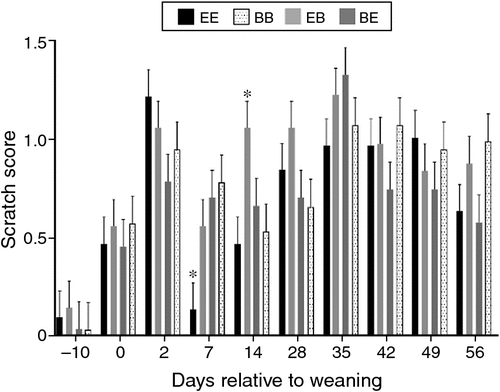The effects of provided enrichment in the sucker phase on piglet scratch score post-weaning
L. A. McKenny A E , G. M. Cronin C , M. L. Hebart A , K. J. Plush D and C. R. Ralph BA The Animal Welfare Science Centre, The University of Adelaide, Roseworthy, SA 5371.
B The Animal Welfare Science Centre, South Australian Research and Development Institute, Roseworthy, SA 5371.
C The University of Sydney, School of Life and Environmental Sciences, Camden, NSW 2570.
D Sunpork Solutions, Wasleys, SA 5400.
E Corresponding author. Email: lisa.mckenny@adelaide.edu.au
Animal Production Science 57(12) 2456-2456 https://doi.org/10.1071/ANv57n12Ab092
Published: 20 November 2017
At weaning, piglets are exposed to an array of changes; environmental, social and or nutritional. These changes can result in increased aggressive behaviour (e.g. fighting, mounting), as well as redirected behaviour (e.g. belly nosing, tail biting) (Cox and Cooper 2001; Dudink et al. 2006). Environmental enrichment can provide both a play stimulus and nutritional supplement. Few studies have demonstrated the effects of enrichment throughout the sucker phase. Therefore, this trial tested the hypothesis that the provision of enrichment during the sucker and weaner phases would result in a decreased scratch score and increased piglet growth. At 7 days of age, 96 piglets from 24 litters were randomly allocated to one of two treatments. Piglets were either provided with one cube shaped enrichment block (specifically formulated by Ridleys Corporation Ltd, Toowong, Qld, Australia) per four piglets (enriched), or no enrichment blocks were provided (barren). The blocks were adjusted in size to suit the age of the piglet during the sucker and weaner phases. Four focal piglets per litter were tagged for identification and weaned at 21 days of age, such that half of the piglets in each lactation treatment (enriched or barren) were weaned into either an enriched (with blocks) or barren (without blocks) environment. The final four treatments consisted of; enriched in sucker and weaner phases (EE), enriched in sucker phase and barren in weaner phase (EB), barren in sucker phase and enriched in weaner phase (BE) and barren in sucker and weaner phases (BB), n = 24 per treatment. The piglets were weighed and a scratch score of 0 to 3 (Widowski 2003) recorded weekly throughout the 11-week experiment. Six fresh blocks were introduced to the enriched pens each week. Data were analysed using a mixed model (ASReml v4, VSN International, Hemel Hempstead, UK), with treatment, phase and week as fixed effects. Results are presented in Fig. 1. There was no effect of enrichment on growth rate throughout the 11 weeks (P > 0.05). There was a significant sucker × weaner × week interaction for scratch score (P < 0.05). Animals in EE treatment had significantly fewer scratches than those in BB, BE and EB treatment at d 7 post weaning (P < 0.05). Piglets in the EB treatment had significantly greater scratches than piglets in the other treatments at d 14 post weaning (P < 0.05).

|
The data partially supported the hypothesis as there were differences in scratch scores, but not in growth rate. Animals that were enriched in both the sucker and weaner phase had lower scratch scores at d 7 post-weaning, potentially indicating that enrichment reduced aggression at this time. Data suggested that providing piglets with enrichment in the sucker phase, but not in the weaner phase, could have negative impacts on behaviour; evidenced by the increase in scratch scores in EB piglets at 14 days post-weaning. Overall, the provision of enrichment in the sucker and weaner phase has the potential to reduce aggression and result in less scratches.
References
Cox LN, Cooper JJ (2001) Animal Science 72, 75–86.| Crossref | GoogleScholarGoogle Scholar |
Dudink S, Simonse H, Marks I, de Jonge HF, Spruijt MB (2006) Applied Animal Behaviour Science 101, 86–101.
| Crossref | GoogleScholarGoogle Scholar |
Widowski TM (2003) Journal of Swine Health and Production 11, 181–185.
Supported in part by Australian Pork Limited. Thanks to Tanya Nowland, Jessica Zemitis, Serena Barnes and Laura Marsh for technical assistance and Ridleys Corporation Ltd (Rob Parkes and Matt Callaghan) for supplying blocks.


